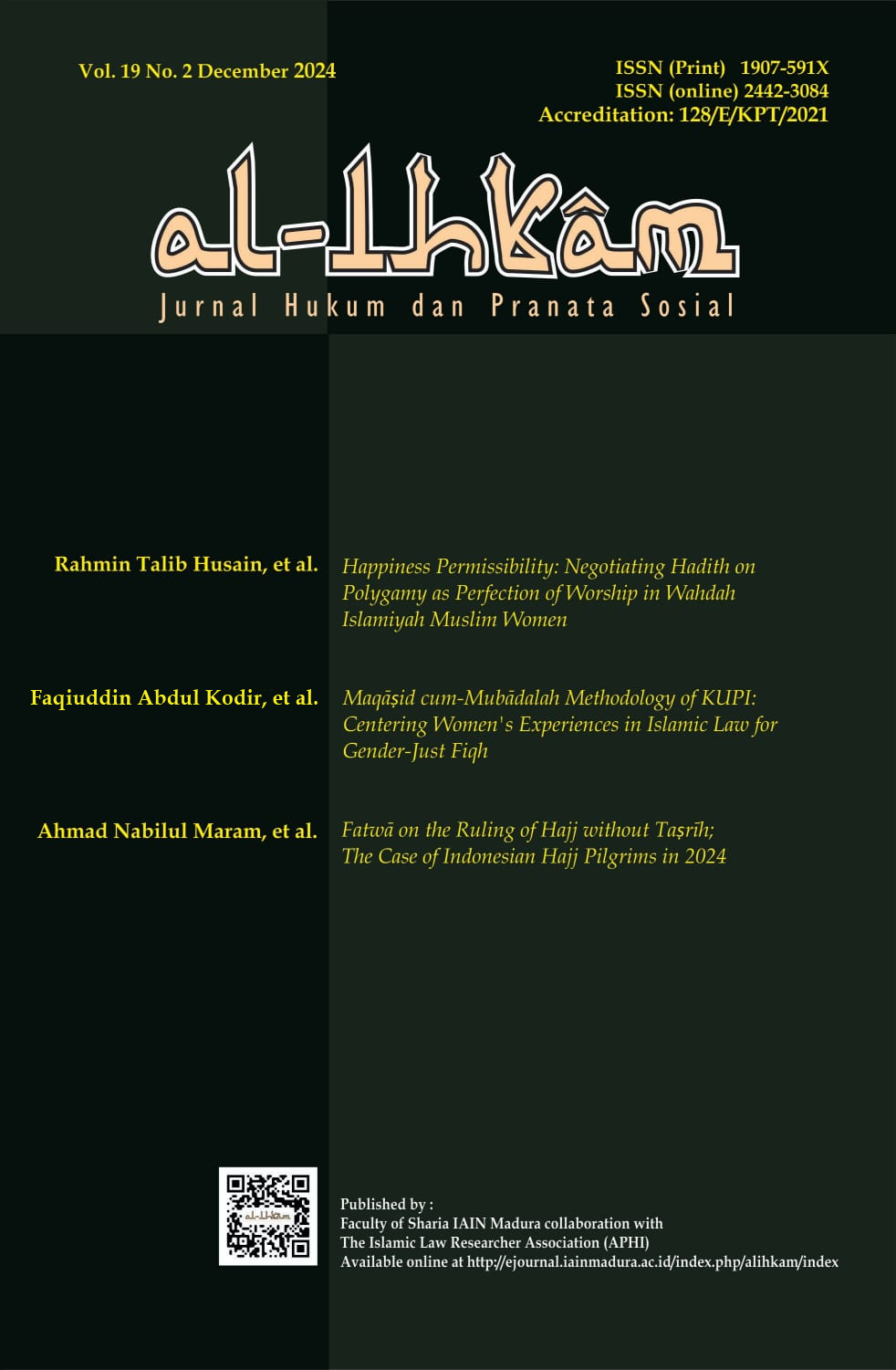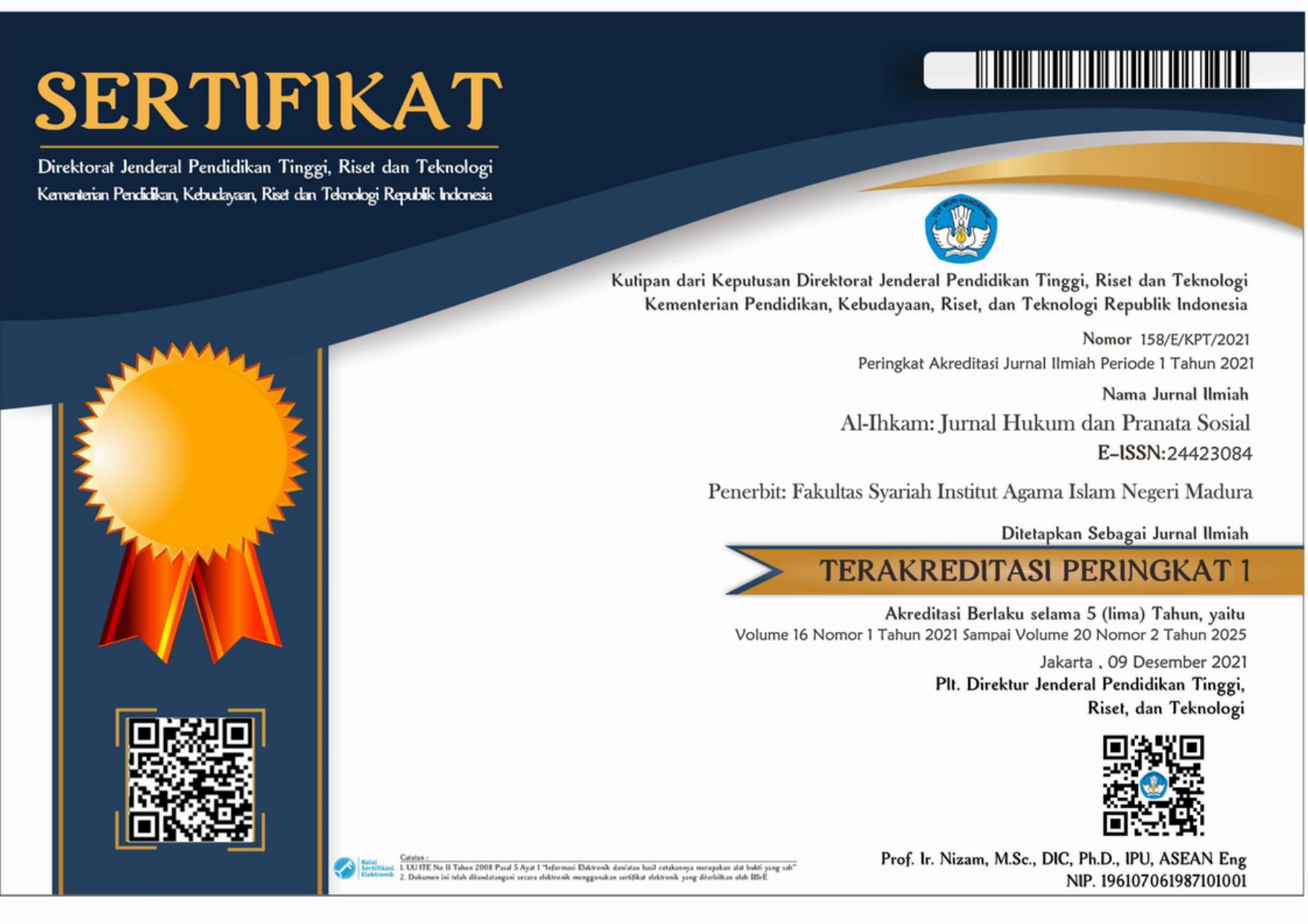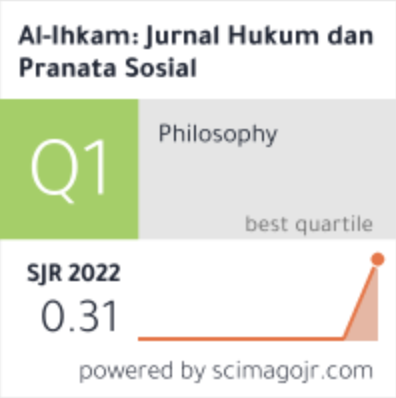The Symbol of Acculturation and Islamic Unity in Nganggung Tradition of Bangka: An Integration of Maqāṣid asy-Syarī’ah with Local Wisdom
 Abstract views: 599
,
Abstract views: 599
,
 PDF downloads: 525
PDF downloads: 525
Abstract
This paper aims to explore the integration of traditional and modern Islam in nganggung tradition of Bangka society. Nganggung is a customary practice of bringing food with specific procedures and attributes to commemorate important Islamic holidays. It existed for a long time as a tradition in Bangka conducted by traditionalists. Recently, modernists also participated in the event, making nganggung a melting pot that blends traditionalists and modernists. While associated with traditional Islam, this practice has also involved modern practices. The research was carried out in Kemuja and Kenanga villages on Bangka Island, using interviews, participatory observation, and a literature review. It addresses three key questions: How is local wisdom in the nganggung tradition expressed in contemporary Bangka society? How can this wisdom strengthen ties between traditional and modern Islam? What is the role of maqāṣid asy-syarī’ah in sustaining this wisdom for lasting harmony? Findings show modernists' participation arises from respect for traditional Islam. While nganggung has adapted to include all groups, changes remain minor. It continues to unite society, sustained by Islamic values and maqāṣid asy-syarī’ah.
Downloads
References
Afandi, Syed Agung, Reski Lestari, and Muslim Afandi. “Collaborative Governance in Preserving the Malay Culture of Riau.” Jurnal Ilmiah Peuradeun 9, no. 2 (2021): 483–500. https://doi.org/10.26811/peuradeun.v9i2.525.
Azhar. “Islamic Law Reform in Indonesia from the Perspective of Maqāṣid asy-Syarī‘ah: Kerinci’s Intellectual Views.” Samarah 8, no. 2 (2024): 750–69. https://doi.org/10.22373/sjhk.v8i2.15051.
Azra, Azyumardi. “Cultural Pluralism in Indonesia: Continuous Reinventing of Indonesian Islam in Local, National and Global Contexts.” Annual Conference on Islamic Studies 2, no. 2 (2018): 56–60. https://doi.org/http://dx.doi.org/10.24014/apjrs.v2i2.6399.
Barton, Greg, Ihsan Yilmaz, and Nicholas Morieson. “Authoritarianism, Democracy, Islamic Movements and Contestations of Islamic Religious Ideas in Indonesia.” Religions 12, no. 641 (2021): 1–20. https://doi.org/10.3390/rel12080641.
Brown, Gustav. “Civic Islam: Muhammadiyah, NU and the Organisational Logic of Consensus-Making in Indonesia.” Asian Studies Review 43, no. 3 (2019): 397–414. https://doi.org/10.1080/10357823.2019.1626802.
Deqy, Teungku Sayyid, and Djalaluddin. Korpus Mapur dalam Islamisasi Bangka. Yogyakarta: Ombak, 2014.
Dhofier, Zamakhsyari. Tradisi Pesantren, Studi tentang Pandangan Hidup Kyai. Jakarta: LP3ES, 1982.
Djamil, Abdul. “Challenges of Religious Harmony in Indonesia: A Historical Perspective.” In 2nd International Conference on Democracy and Social Transformation (ICON-DEMOST 2023), 31–36. Atlantis Press SARL, 2023. https://doi.org/10.2991/978-2-38476-174-6_6.
El-Mesawi, Mohamed El Tahir. “Maqāṣid asy-Syarī‘ah: Meaning, Scope and Ramifications.” Al-Shajarah, 2020. https://doi.org/https://doi.org/10.31436/shajarah.v25i2.1141.
Elvian, Ahmad. Memarung, Panggung, Bubung, Kampung dan Nganggung. Pangkalpinang: Dinas Kebudayaan, Pariwisata, Pemuda dan Olahraga Kota Pangkalpinang, 2015.
Fanani, Muhyar, and Bambang Iswanto. Critique on Salafibism and It’s Significance for Indonesian Islamic Moderation: Study on Khaled Abou El-Fadhl’s Thought. Mazahib Jurnal Pemikiran Hukum Islam. Vol. 22, 2023. https://doi.org/10.21093/mj.v22i2.7046.
Fauzan, Pepen Irpan, and Ahmad Khoirul Fata. “Madjlis Ahli Soennah Garoet: Local Islamic Puritanism Movement and Its Roles in West Java during the Colonialism Era of 1926 – 1942.” Journal of Al-Tamaddun 17, no. 1 (2022): 141–55. https://doi.org/10.22452/JAT.vol17no1.11.
Hilmy, Masdar. “The Double-Edged Sword of Islamic Reform: Muhammadiyah and the Dilemma of ‘Tajdīd’ within Indonesian Islam.” RIMA: Review of Indonesian and Malaysian Affairs 48, no. 1 (2014): 183–206. https://doi.org/https://search.informit.org/doi/10.3316/ielapa.896088036918300.
Hobson, Nicholas M., Juliana Schroeder, Jane L. Risen, Dimitris Xygalatas, and Michael Inzlicht. “The Psychology of Rituals: An Integrative Review and Process-Based Framework.” Personality and Social Psychology Review 22, no. 3 (2018): 260–84. https://doi.org/10.1177/1088868317734944.
Idi, Abdullah. Bangka: Sejarah Sosial Cina-Melayu. Yogyakarta: Tiara Wacana, 2011.
Karim, Zulkarnain. Kapita Selekta Budaya Bangka. Bangka: Badan Pembinaan Kesenian Daerah Bangka, 1996.
Khalikin, Ahsanul, and Reslawati. “The Dynamics of Religious Moderation in Bangka Island.” In Proceedings of the 3rd International Symposium on Religious Life, 1–15. Bogor: ISLR, 2020. https://doi.org/10.4108/eai.2-11-2020.2305035.
Lukens-Bull, Ronald, and Mark Woodward. “Variation of Muslim Practice in Indonesia.” In Handbook of Contemporary Islam and Muslim Lives, 1:619–40. Cham: Springer International Publishing, 2021. https://doi.org/10.1007/978-3-030-32626-5_78.
Millah, Ahmad Sihabul, Yuni Ma’rufah, and Khoirul Imam. “Habituation of Local Culture in Order to Prevent Religious Radicalism in Sukoharjo, Central Java.” ESENSIA: Jurnal Ilmu-Ilmu Ushuluddin 19, no. 2 (2018): 199–208. https://doi.org/10.14421/esensia.v19i2.1736.
Millie, Julian. “The Situated Listener as Problem: ‘Modern’ and ‘Traditional’ Subjects in Muslim Indonesia.” International Journal of Cultural Studies 16, no. 3 (2013): 271–88. https://doi.org/https://doi.org/10.1177/1367877912474536.
Mukharrom, Tamyiz, and Supriyanto Abdi. “Harmonizing Islam and Human Rights Through the Reconstruction of Classical Islamic Tradition.” Samarah 7, no. 1 (2023): 40–57. https://doi.org/10.22373/sjhk.v7i1.16436.
Mukti, M Aziz, and Irfan Zakariah. “Konflik Kelompok Puritanis dan Tradisionalis dalam NII (Negara Islam Indonesia) di Indonesia 1971-1992 M.” Fihros 7, no. 02 (2023): 13–24. https://ejournal.staisyekhjangkung.ac.id/index.php/fihros/article/view/77.
Munir, Muhammad, and Muhammad Tayyeb Nadeem. “Maqāṣid asy-Syarī‘ah Between Classical and Postmodern Periods: An Advanced Islamic Juridical Context.” MEI: Maʻārif-e-Islāmī 22, no. 2 (2023): 1–10. https://ojs.aiou.edu.pk/index.php/jmi/article/view/1442.
Muthmainnah, Anti, and Dinie Anggraeni Dewi. “Implementasi Nilai-Nilai Pancasila dalam Tradisi Nganggung di Kepulauan Bangka Belitung.” Edumaspul: Jurnal Pendidikan 5, no. 1 (2021): 515–21. https://doi.org/10.33487/edumaspul.v5i1.1261.
Nur, Iffatin, Syahrul Adam, and M. Ngizzul Muttaqien. “Maqāṣid asy-Syarī‘ah: The Main Reference and Ethical-Spiritual Foundation for the Dynamization Process of Islamic Law.” Ahkam: Jurnal Ilmu Syariah 20, no. 2 (2020): 331–60. https://doi.org/10.15408/ajis.v20i2.18333.
Pandie, Daud, Izak YM Lattu, Suwarto Suwarto, and Lobby Lukmono. “The Construction of Ethnoreligious Identity among Muslims and Christians in Rote Ndao Regency, Indonesia.” IJoReSH: Indonesian Journal of Religion, Spirituality, and Humanity 3, no. 1 (2024): 101–25. https://doi.org/10.18326/ijoresh.v3i1.101-125.
Rahman, Muhammad. “Islamic Revival in Indonesia: From Purification of Religion to Social Innovations.” In 2nd Conference on Contemporary Arab and Muslim World in International Relations., 1–26. Polandia: Gdansk, 2016. https://doi.org/10.2139/ssrn.3053461.
Rahmatiah, H. L., Tri Suhenra Arbani, Risnah, and Rahmatul Akbar. “Strict Liability and Product Safety: The Case of Dangerous Syrup in Indonesia in the Maqāṣid asy-Syarī‘ah Perspective.” Ahkam: Jurnal Ilmu Syariah 23, no. 2 (2023): 543–62. https://doi.org/10.15408/ajis.v23i2.34240.
Rasyid, Ambar. “Mistik, Ontologis, dan Fungsional (Budaya Hukum Islam : A New Perspective).” Al-Risalah: Forum Kajian Hukum Dan Sosial Kemasyarakatan 15, no. 1 (2015): 40–57. https://doi.org/https://doi.org/10.30631/alrisalah.v15i01.378.
Sila, Muhammad Adlin. “Revisiting Nu-Muhammadiyah in Indonesia: The Accommodation of Islamic Reformism in Bima.” Indonesia and the Malay World 48, no. 142 (2020): 304–22. https://doi.org/10.1080/13639811.2020.1823150.
Stein, Daniel H., Nicholas M. Hobson, and Juliana Schroeder. “A Sacred Commitment: How Rituals Promote Group Survival.” Current Opinion in Psychology 40 (2021): 114–20. https://doi.org/10.1016/j.copsyc.2020.09.005.
Sulaiman, Rusydi. “Dinamika Peradaban Kampung di Bangka.” Mawa’Izh: Jurnal Dakwah dan Pengembangan Sosial Kemanusiaan 10, no. 2 (2019): 190–213. https://doi.org/10.32923/maw.v10i2.978.
Suparta. “Nilai-Nilai Pendidikan Islam dalam Budaya Nganggung dan Implikasinya Terhadap Solidaritas Umat di Kecamatan Mendo Barat Kabupaten Bangka.” Madania: Jurnal Kajian Keislaman 21, no. 1 (2017): 101–12. https://doi.org/10.29300/madania.v21i1.206.
Susanto, Aris, Ali Rahmat Unton, Lismawati Sudiah, Silvia Agnesi Wali, Rahmawati Nurkarimah, Karim, and Rizal. “Penguatan Nilai-Nilai Luhur Kerajaan Kesultanan Buton Pada Mahasiswa STKIP Pelita Nusantara Buton dalam Implementasi Pendidikan Karakter Berbasis Kearifan Lokal Budaya Buton.” Journal of Human And Education 3, no. 4 (2023): 399–403. https://doi.org/https://doi.org/10.31004/jh.v3i4.486.
Syar’i, Makmun. “Mohammed Arkoun’s Thought on Sharia Deconstruction: A Historical and Anthropological Approach.” Mazahib Jurnal Pemikiran Hukum Islam 21, no. 2 (2022): 291–314. https://doi.org/10.21093/mj.v21i2.5131.
Umami, Ulul, and Abdul Ghofur. “Human Rights in Maqāṣid asy-Syarī‘ah Al-Āmmah: A Perspective of Ibn ‘Āshūr.” Al-Ahkam: Jurnal Pemikiran Hukum Dan Islam 32, no. 1 (2022): 87–108. https://doi.org/10.21580/ahkam.2022.32.1.9306.
Zulkifli. Kontinuitas Islam Tradisional di Bangka. Bangka: Siddiq Press, 2015.
———. “Struggling for Islamic Caliphate in a Changing Malay Society.” Ulumuna 28, no. 1 (2024): 224–56. https://doi.org/10.20414/ujis.v28i1.794.
Copyright (c) 2024 AL-IHKAM: Jurnal Hukum & Pranata Sosial

This work is licensed under a Creative Commons Attribution-ShareAlike 4.0 International License.
In order to be accepted and published by Al-Ihkam: Jurnal Hukum dan Pranata Sosial, author(s) submitting the article manuscript should complete all the review stages. By submitting the manuscript, the author(s) agreed to the following terms:
- The copyright of received articles shall be assigned to Al-Ihkam: Jurnal Hukum dan Pranata Sosial as the publisher of the journal. The intended copyright includes the right to publish articles in various forms (including reprints). Al-Ihkam: Jurnal Hukum dan Pranata Sosial maintain the publishing rights to the published articles.
- Authors are permitted to disseminate published articles by sharing the link/DOI of the article at Al-Ihkam: Jurnal Hukum dan Pranata Sosial. Authors are allowed to use their articles for any legal purposes deemed necessary without written permission from Al-Ihkam: Jurnal Hukum dan Pranata Sosial with an acknowledgment of initial publication to this journal.
- Users/public use of this website will be licensed to CC-BY-SA.



.png)
_1.png)










